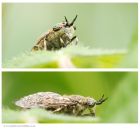
Notch-horned Cleg Fly - Haematopota pluvialis169 viewstheir eyes maybe amazing/fascinating, but female Clegs gorge on blood & give a painful bite
photographed @ Devonshire Road Rock Gardens, Blackpool
|
|

Capsid bug - Heterotoma planicornis159 viewsa new sighting for our garden (Bispham, Blackpool), common in southern England, this Capsid Bug is recognised by the enlarged antennae & pale green legs.
|
|

Capsid bug - Heterotoma planicornis167 viewsa new sighting for our garden (Bispham, Blackpool), common in southern England, this Capsid Bug is recognised by the enlarged antennae & pale green legs.
|
|

Tadpole with legs262 viewsphotographed in our garden pond in Bispham, Blackpool
|
|

Yellow Dung Fly183 viewsThis Dung Fly appears to have been a victim of Entomophthora muscae fungus, which, "once the fungus is inside the fly it grows into the brain, causing a change in behavior.
Instead of acting normally, the fly crawls as high as possible on the branch, flower, stem or leaf it is on, spreads out its legs, stretches opens its wings and angles the abdomen away from the surface. This position improves the chances of the fungal spores leaving the dead fly and infecting new hosts"
|
|
|
|
|
|
|